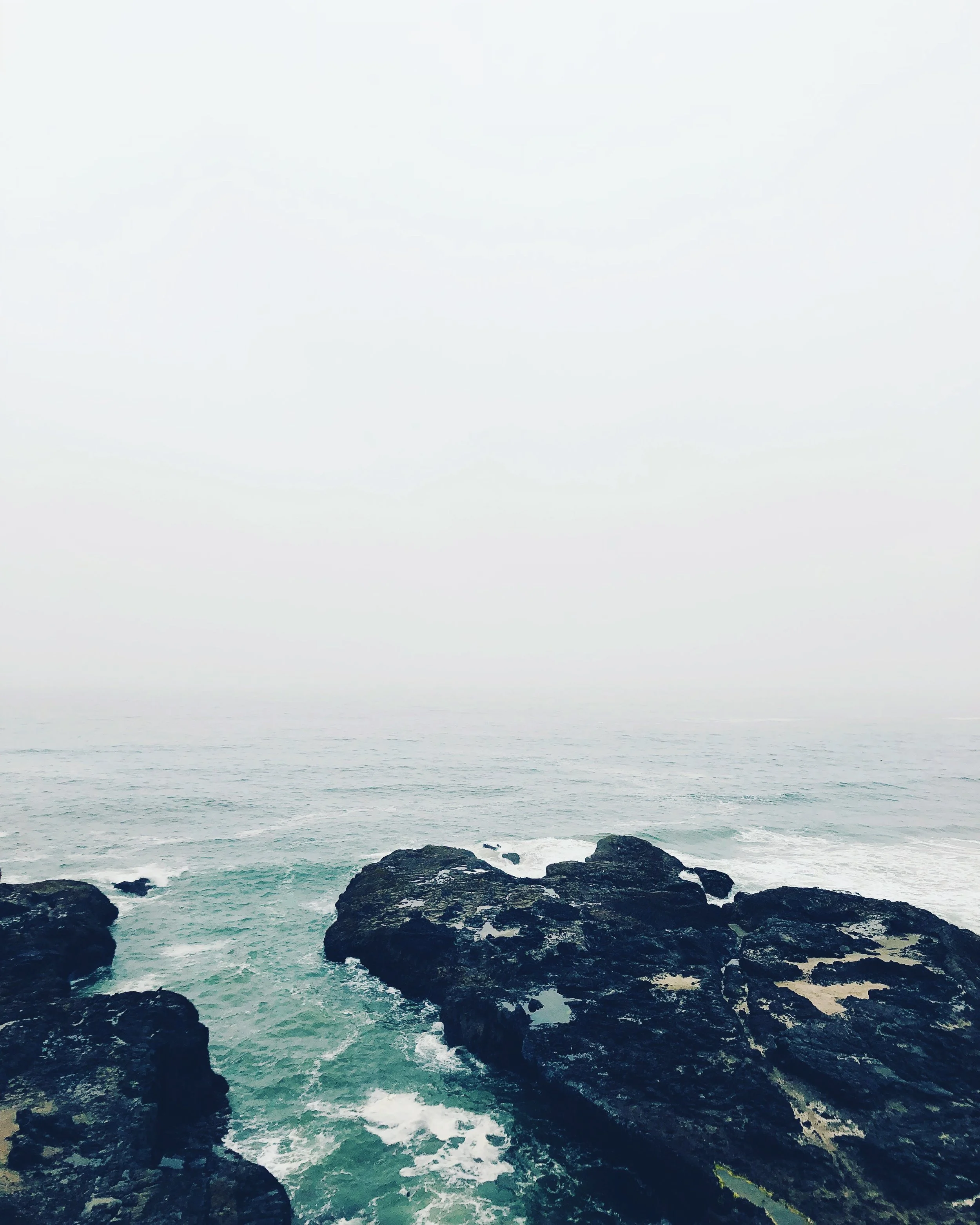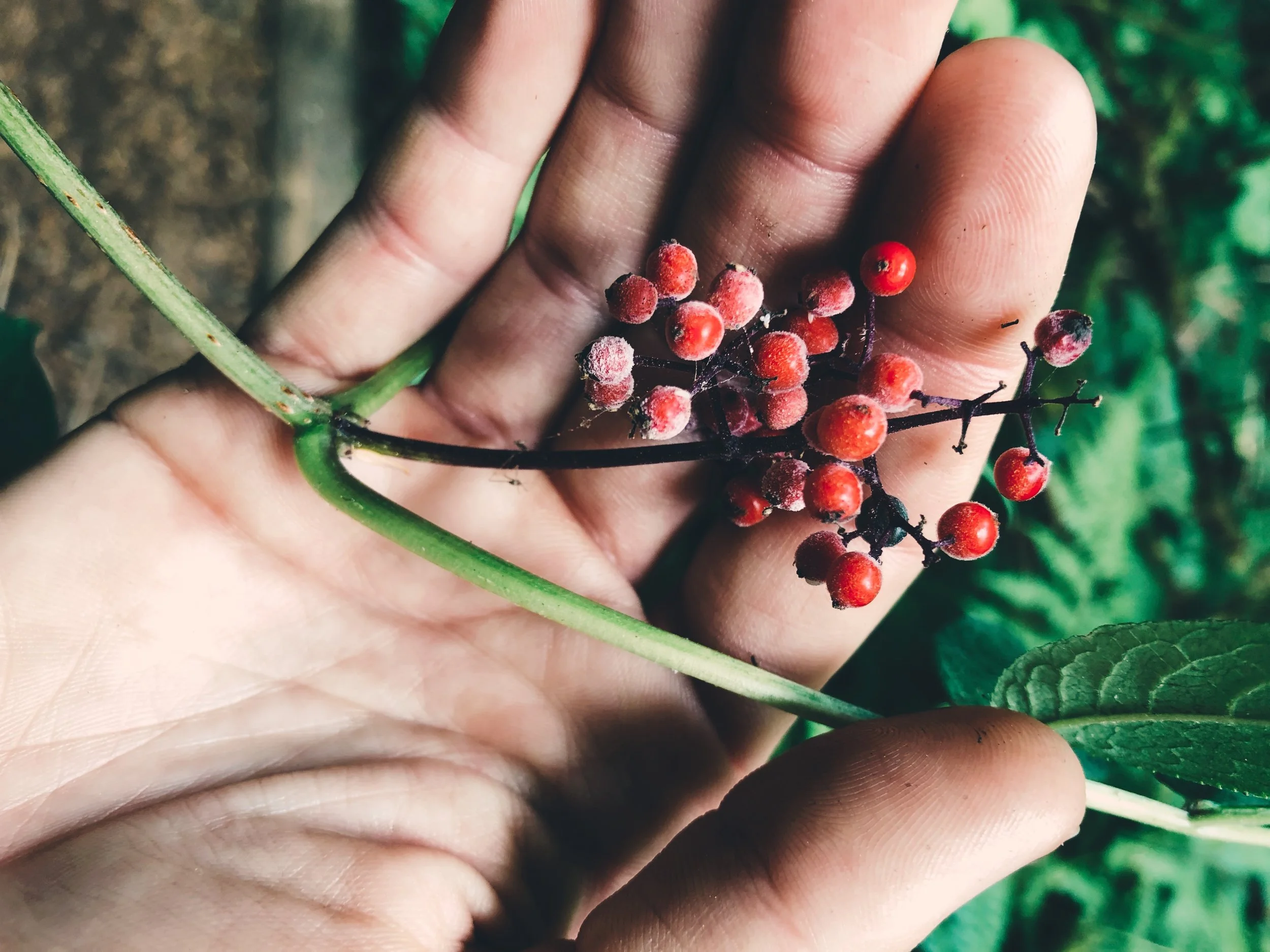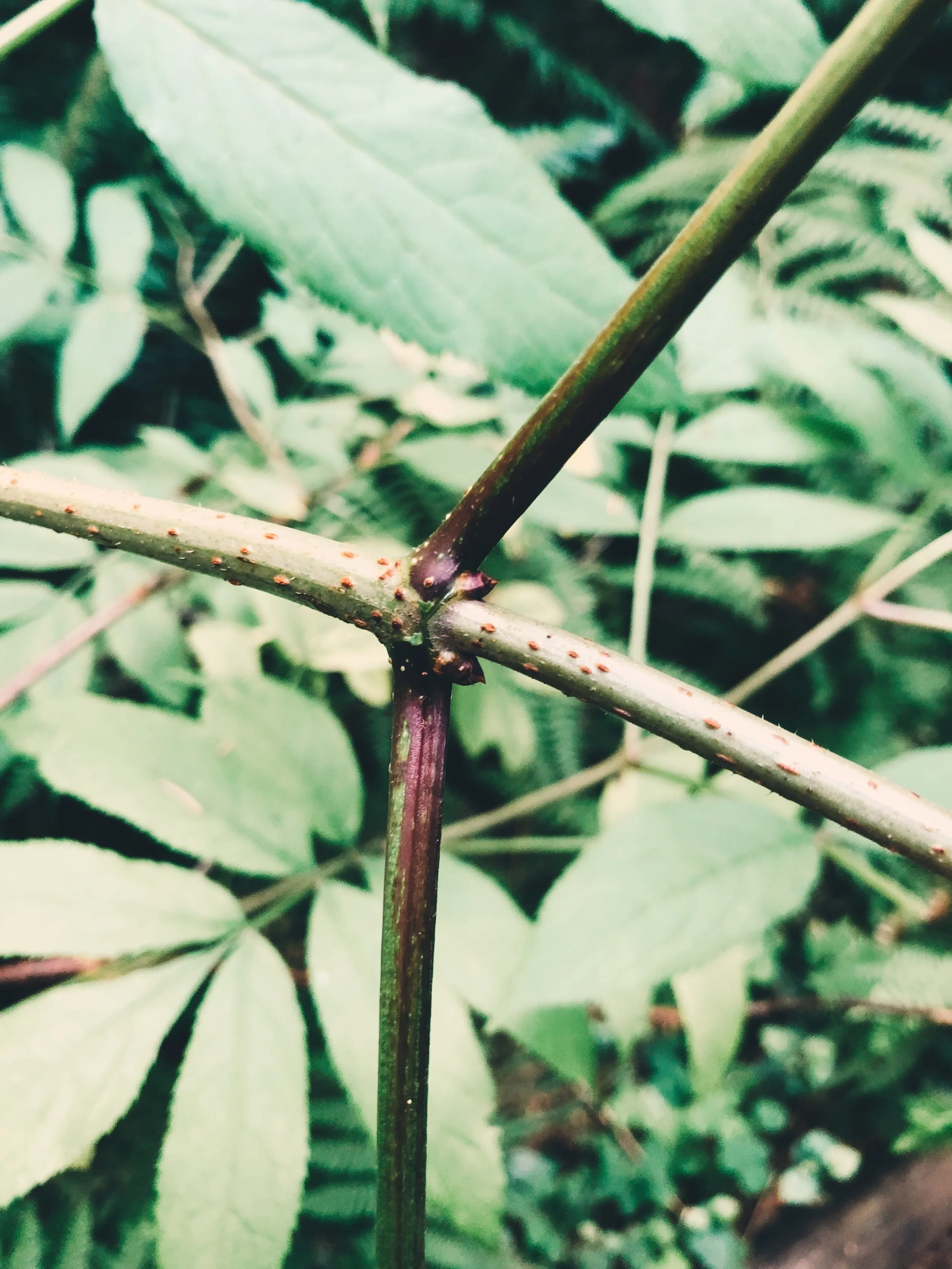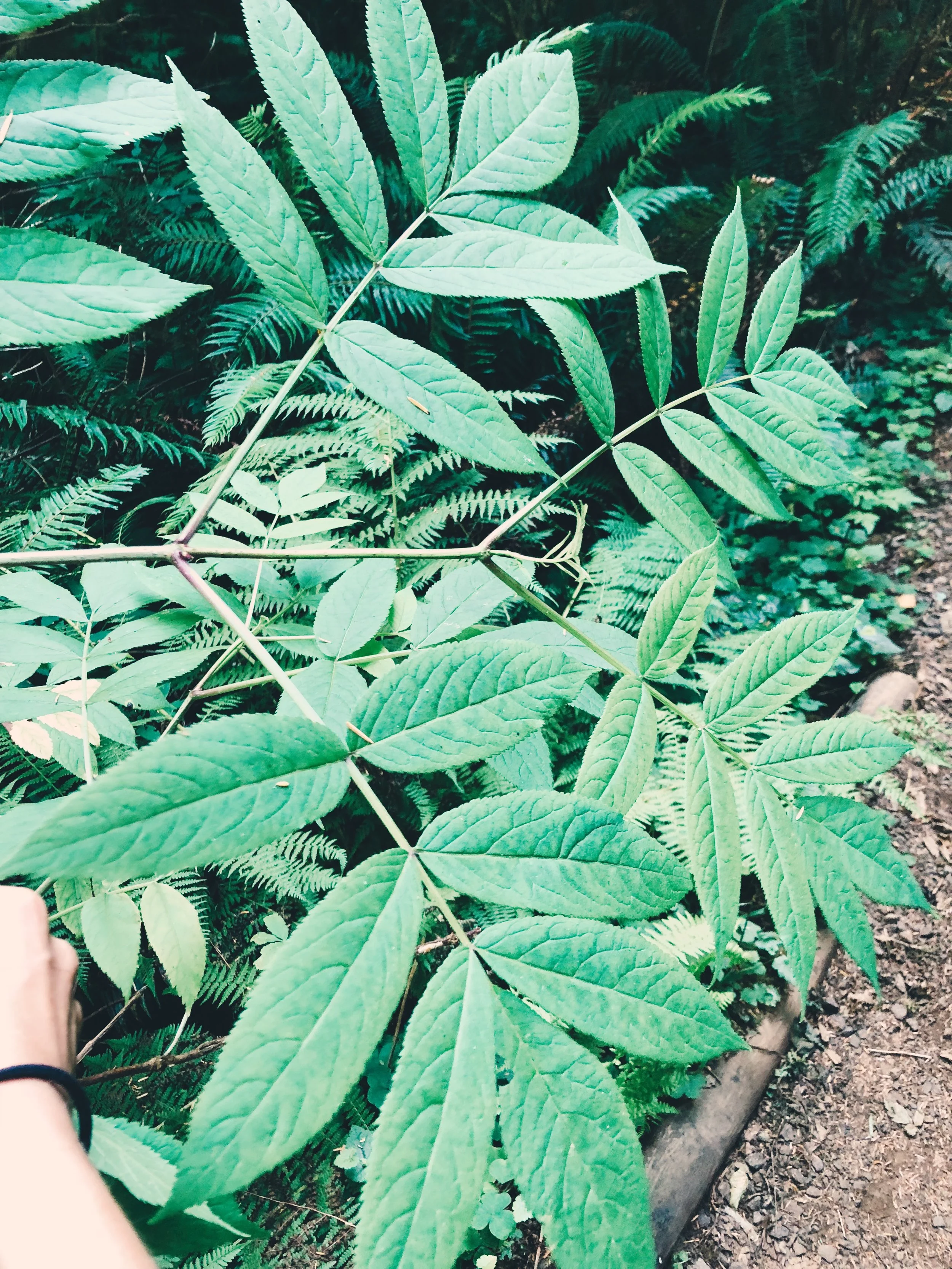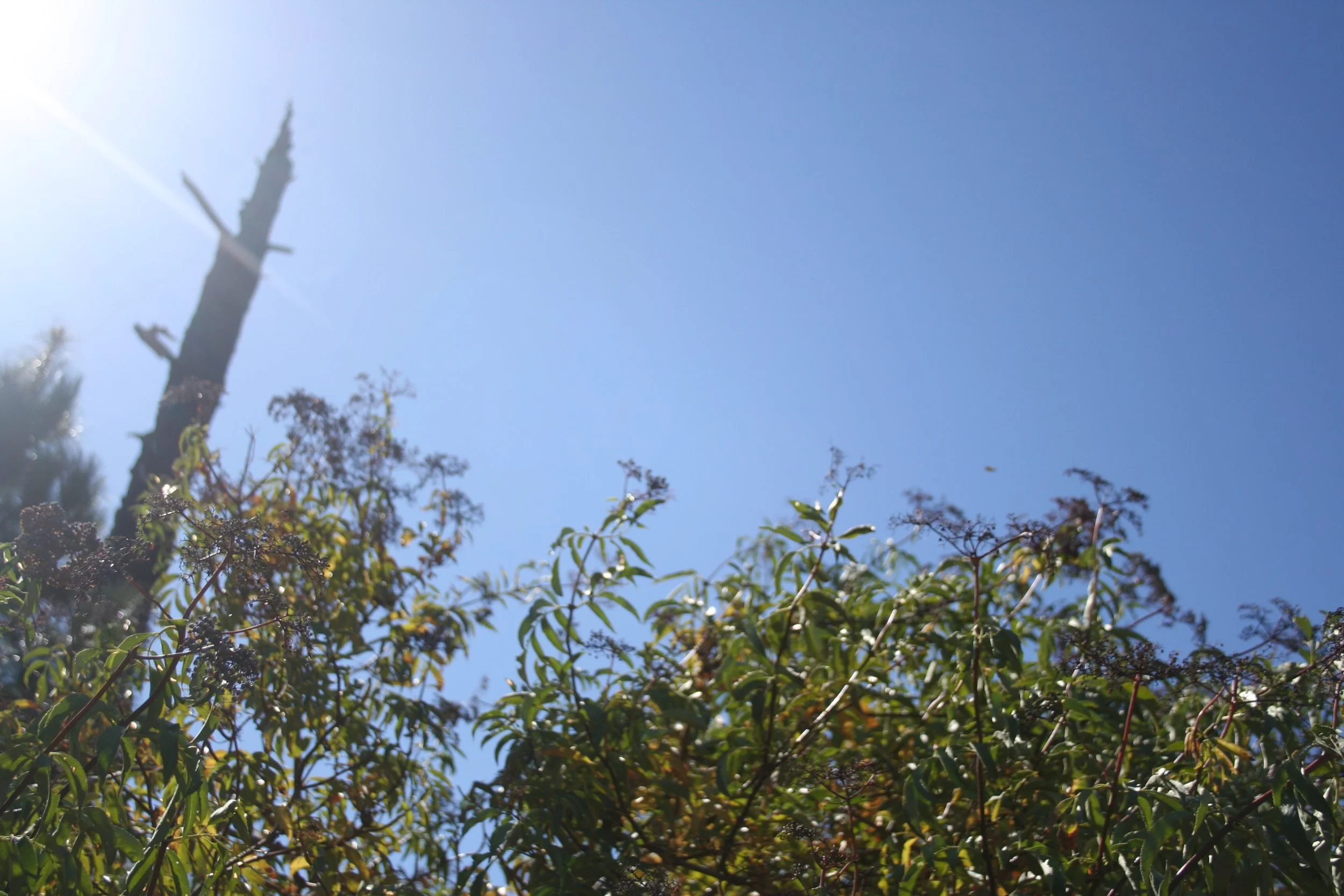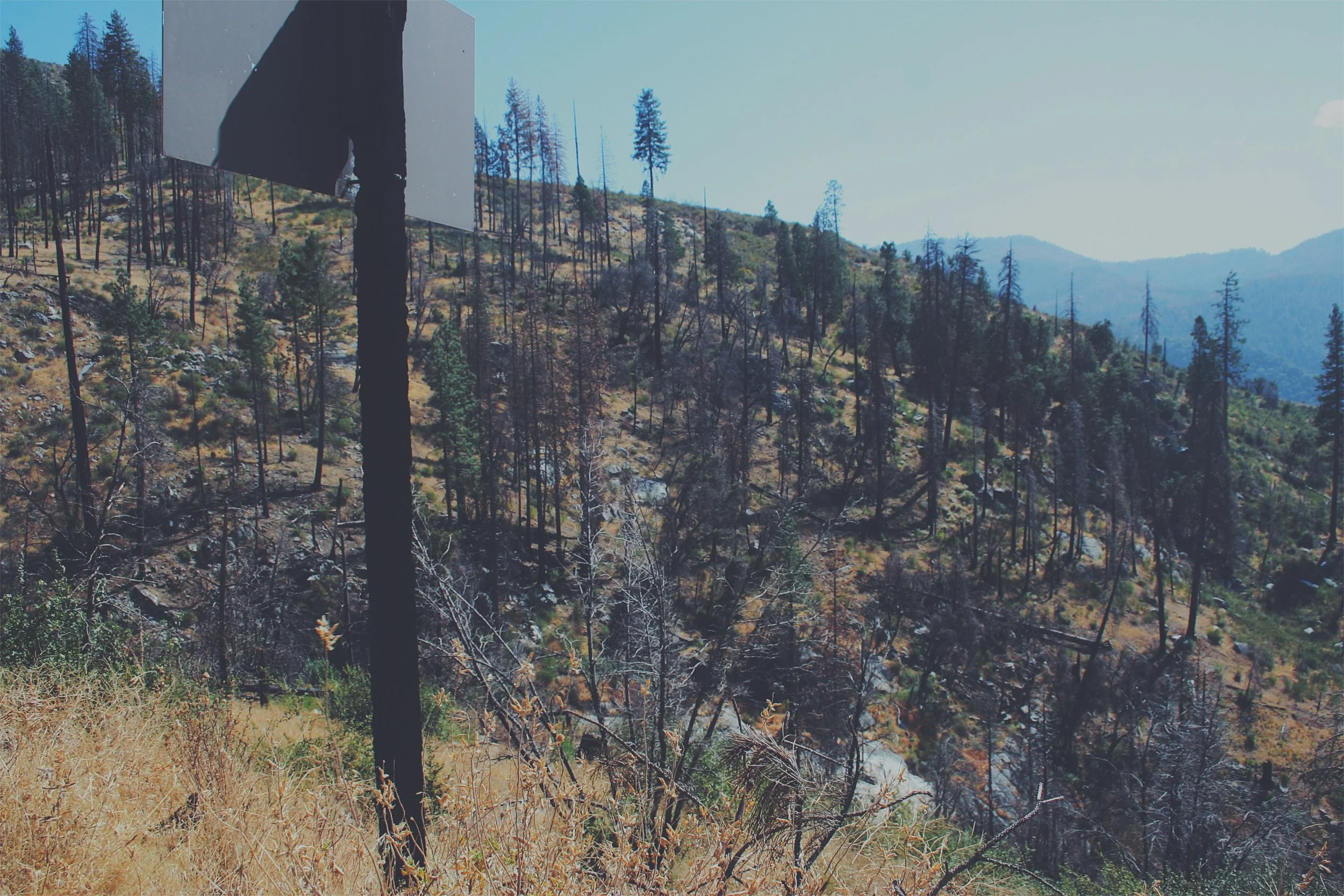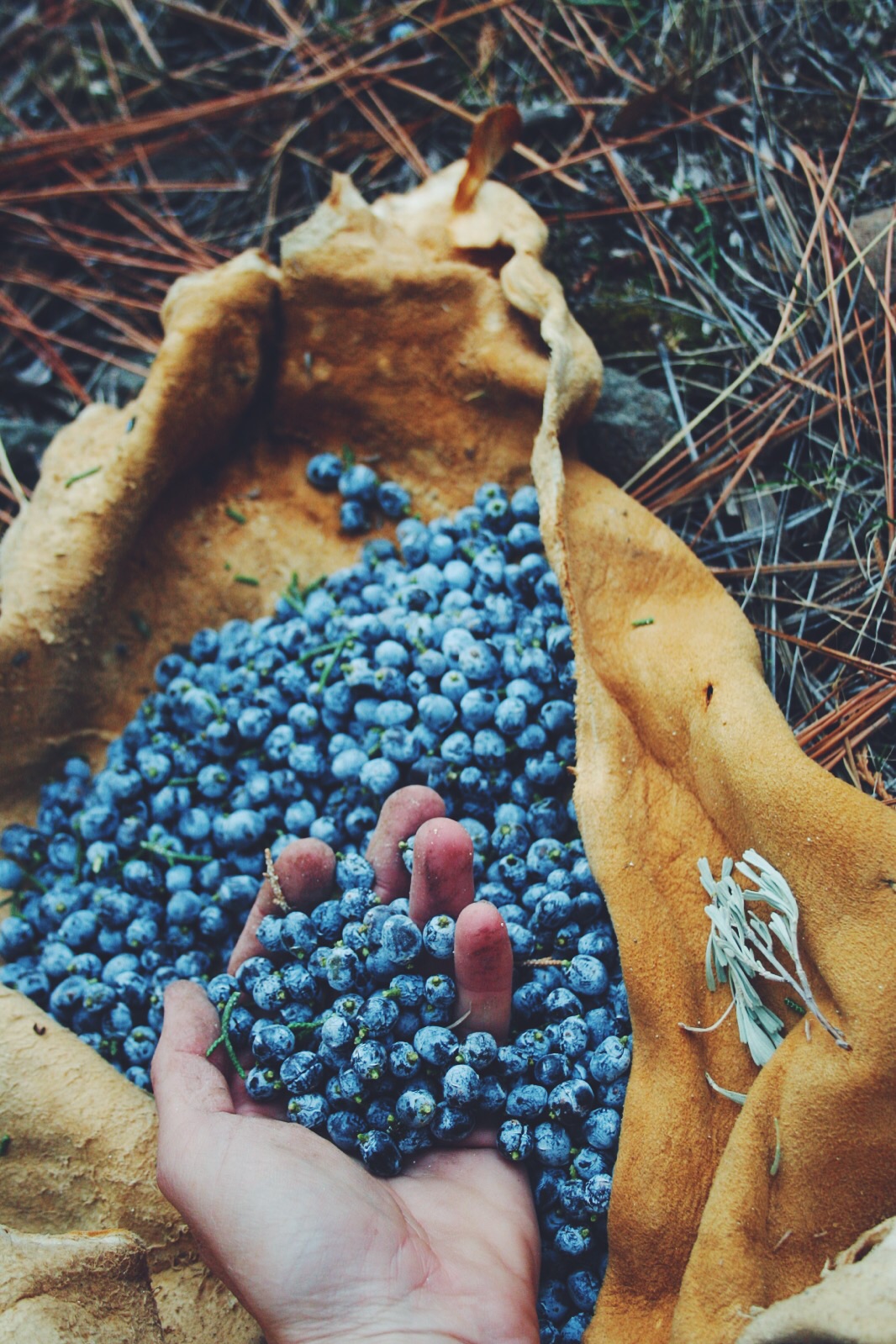This one starts with a story. Not with the plant family.
This morning I set out on a walk up a damp trail, coated in fog. Moss covered Hemlock (Tsuga heterophylla) and Sitka Spruce (Picea sitchensis) trees shaded the path, Alder (Alnus rubra) and Red Elderberry (Sambucus racemosa) took up space just above my head. Sometimes the Elderberries towered over like small trees, and their bark and warty branches housed a colony of ferns and various epiphytes.
I walked up this trail after spending a night stealth sleeping within sight of the Pacific Ocean, something I've never done so darn close, or within the zone that would be wiped away by a tsunami. I opened my camper's icebox fridge and found various Elderberry syrups this morning after waking early to watch the cool mist float over the waters and tall conifer trees surrounding me. Some of the labels are smeared from cheap printing, some are intact from nicer runs. Some, label-less, with the medicine color shining through clear glass. Purple. I take a splash of syrup and put it in my morning coffee made with coconut creme I found in a can during my last grocery shop. Just plain coconut, nothing more. One of my bottles has an embarrassing bloated topper, from my mistake making an Elderberry Elixir batch with not enough honey. Or maybe it was just right for making Elder soda, or Elder mead.
On the trail, going steadily uphill, I am followed by a murder of crows hopping from one Devil's Club (Oplopanax horridus) palmate leaf open handed to another. The car sounds disappear and I go deeper into to quiet dampness, and into the company of trees that have seen a lot of change these past 600 years. Ferns, Wild Ginger (Asarum caudatum), Wood Sorrel (Oxalis sp.), Salal (Gaultheria shallon) surround me. I put on my green fleece over my Black Walnut (Juglans nigra) and Yellow Dock (Rumex crispus) seed leaf-print dyed silk shirt made by a friend, and then take it off. On, then off. Movement much needed after a week and a half of being sick, I try to walk fast to get my heart rate up. I cry at the sight of the old Sitka Spruce, standing nearly alone towering over a younger forest, and this is even with half of its top having fell off in the 1950's. All around this elder (though this isn't actually old for what these trees should be) I find the 'Elder,' Red Elderberry, in fact. The one whose berries have been found in archaeological middens sites belonging to the long time native human inhabitants of the Pacific Northwest coast. This is the one with the red berries, the elongated flower umbels. These are the berries of an Elderberry species that aren't usually recommended for use to make medicine but have a long standing tradition of being an edible and medicinal regionally with extensive boiling or cooking. Red berries scatter the ground, fresh green compound leaflets brush past my resin covered clothes as I walk by. I stop to observe the stem's bamboo like sectioning and notching, the branches bumpy exterior, the opposite branching patterns. I stop to look and awe at Red Elders that seem to be growing out of Alders mid-story, and then I realize that they are just growing closely intertwined. Still nonetheless, they are huge like the Spruce. For someone from the South, they just seem so big compared to what I'm used to. I'm used to fields where they pop up and keep getting cut back. I'm used to seeing them on the roadside and along some creeks in the Appalachian mountains, smaller trunked and delicate berries, often taken by the birds before humans can get very many for their cold remedies.
I've been seeing them a lot this year where fire just swept through. From the high Sierra to Yosemite, where a current fire blazing as I type this has wiped them down again by the very trail I walked this winter on my birthday. In a way they represent grief to me, the way grief flows like water around their roots, slowing feeding them, and changing fast, as they change slower, observing. I am catapulted back to a time when I first thought of Elder this way, from a summer I spent between Ohio and Kentucky, in the sandstone filled rural Appalachia plateau. I chased a mysterious person out of a botanical sanctuary and found myself isolated in a crumbling back-to-the-land community started in the 90's and left to abandon by it's so called 'leader' suddenly dying. I found myself in love with the land and confused by the humans there, including the one I chased to the place. I found myself sitting a lot by the quiet sandy shores of the little South Fork River and watching Elder. I found myself in New Mexico for the first time that summer, doing a meditation with Elder via Robin Rose Bennett where the tree I had been sitting by came to me and showed me things in a way I don't usually perceive. Not that I don't usually perceive this way, but rather, I don't usually admit it publicly, or talk about it openly, or say that this is how I talk to plants. I am very intellectual about things, thank you very much, which is not actually the whole truth at all. What drives me is this kind of space life takes up in the shadows of the mind. What connects the threads that drive me to find Elders, or other plants in distant places are these impressions beyond words. I do not know if Elder has a relationship with grief historically. But for me, it reminds me of the idea that rivers flow while the heart holds on. The river is change, the emotional ups and downs, the attachment to the moment good or bad, the cycles of life and death, and the Elder, roots in that flow and feeding from it, watches in stillness and attachment.
Of course they say that Elderberry is a magical plant.
There's no doubt that it has an ability to charm and trick and bring good luck or bad. I have tried to not look into what others say about it too much until now. I feel like my experience is affirmed by its historical use. It was there to protect me from the dark person I had followed to the woods, but perhaps paradoxically for a reason, to teach me about my own draw towards darkness and its mysteries. That it isn't 'bad' to be drawn there, to see where it takes you. Darkness is not actually a bad thing. It took me there, to the shores of that sandy river, where I had many rituals that also catapulted me to the mountains being blown up nearby for coal, to the last Ginseng being dug up by a neighbor for drug money. For the darkness that was held there, it gave me some intuitive advice that I didn't even know what advice at that moment. Leave now, from this relationship with the land. I did leave, with grief and mixed emotions for what Elder was telling me, but somehow my body knew. I came back later in a different way to connect with human neighbor elders I met, who taught me about harvesting wheat by hand, building with Chestnut, Black Walnut groves, and more. I took the droves of seed ticks off my legs with duck tape that summer I found Elder, somehow I didn't get Lyme (knock on light fast growing Elder wood).
I was fascinated to find a sea of Elder containers made by Tamara Wilder at a so called traditional skills gathering in Arizona. Back in the southwest, where I first found Elder in the mind, I see Tamara's spread of Elder branches carefully cut, sanded, hollowed out and corked with intent to store little things of meaning or use. An aha moment, the idea of Elder protecting the place between realms, of representing the dark and the light spaces, of warding off. Of containing thoughts and emotions. I traded Tamara some canned apple butter from my parent's orchard of heirlooms for a few containers to hold beads and needles. It sits in my tool box, a reminder like a tattoo, of that summer in Kentucky, of the ticks, of the rituals, of the Ginseng, of the cold water, the secretive humans hiding their darkness. Of my solace with Elder alone by the river, of sleeping on the trampoline next to it's slow flow when I didn't know where else to go. Of course some say you should never cut Elderberry wood. That it brings bad luck. That it is only for special occasions.
Elder has been my teacher when the intersections of oppressions merge in a tangled mess of misunderstanding and unintentional hurt. Elder sits listening offering advice to pull the rope this way or that to sort out the pile. I suppose that's why its so much more than an anti-viral herb for our most imbalanced days, for when our white blood cells need a boost. When one tries not to take up space one way, inevitably more room is taken up somewhere else. Less space is actually not taken up, she warns, only different space in different ways, as she watches from her silted perch riverside or mid-river amongst the slow flowing waters. She dangles fruits for birds and humans to strengthen those boundaries, of self and not self, of where to put the space we take up, of what should take up our space and what does not belong. Her leaves and stems, not to be used lightly, work on the way our bodies inhabit the space we are given and born with.
Sometimes plant medicine for me is merely seeing or being in the presence of a plant, of seeing it again after a long hiatus, sometimes at the right place at the right time. Of having a friend when no other friend seems to be there. Why Red Elder, today of all days? When the mist of the coast coats the air and hangs the sky low and close, hugging a cold wet around my body, my camper, my thoughts, and my grief swells around my relationship to my own space and how I use it, take it up, fail to have good boundaries around it, or have too strict of boundaries. Trained as a child to not take up too much space around addicts, so as to not stir them, and quieted to nearly mute for years until finding my voice and slowly unfolding over the years. The fear of offending, of triggering, welling up or initiating violent response has often kept me existing in the silent space of the interior. Why must that safety mechanism be held on to? In this way, one takes up space in the river remaining too rigid, not allowing for change like cement is swollen there, the flow of life continuously happening, despite. In another way, the space taken up can be too much, not community focused, inhibiting the growth and shimmering nature of those around us.
Adoxaceae plant family
I don't have much to say about this family. As it goes in modern botany and scientific testing technologies, plant families are being moved around and shifted due to new data. The Elderberry genus Sambucus used to be in the Caprifoliaceae family, or Honeysuckle family, but after said lab tests, it was determined that the group of plants under the genus Sambucus belong in a different kind of collection. What's the point of all this, you ask? In some ways, take it with a grain of salt. It is just one way of seeing living things and the relationships between them. I am indebted to the perspective of Marc Williams of Botany Everyday, a former teacher, so I can't help but to consider this model of seeing plant relationships. And again, it is just one model. This family is shared with the Viburnums, a genus that some folks may recognize. Plants like Maple-Leaf Viburnum, V. acerifolium, or Wild Raisin, V. cassinoides are just a couple examples.
Sambucus Racemosa or s. pubens
Red Elderberry
duhiembuh (shoshone)
red berries.
bark/branch.
This is a species that when you study Elderberry medicine (however you study), you are mostly told to stay away from it when making medicine. But, in reality, it was used traditionally by native folks of the Pacific Northwest for medicine and food for a long time. Like I mention above, the berries of this species of Elder have been found in ancient human middens (term for trash piles) caches along the coast as old as 5,000 year mixed with charcoal, clam shells sometimes human remains, and more. These middens piles were often revered as special mounds, and were taken from by white settlers for building roads or filling in areas in some instances. These sites are now protected by the state of Oregon. Some of the Red Elder berries found in the middens or cache sites show charring which demonstrates they were probably cooked to make edible. In some instances, just their seeds remain. Other evidence shows that humans specifically cached them. They may have been mixed with other berries to eat or prepared in a way to consume that we cannot totally conclude. (see Haunting History of Native Shell Middens and the Paleoethnobotany article at the bottom of this page) It is true that Elderberry contains cyanide-inducing glycosides in its leaves, stems and berries to different degrees depending on the part of the plant and the species. This specific Elder species was used for colds, as an emetic (to throw up on purpose) and to stop bleeding. Though some herbalists might use it regionally, it is not typically encouraged for use. In some instances, I have seen folks be pretty afraid of this species of Elder, as if it is as poisonous as Poison Hemlock (Conium maculatum), which is not the case.
This species of Sambucus grows in different forms all over the world but I have mostly seen it personally as a distinctive species in moist areas of the Pacific Northwest of the U.S. One of the biggest features that differentiates it from other Elderberry species is its flower shape and structure, as well as the color of it's berries. Before it fruits and is just flowering, or even observing the dead flower remnant from the year before, you can notice that it has a pointy cone shaped inflorescence (flower structure) while other Elder species' flower structures have flatter umbels. It shares characteristics with other Elder species, like the knobby bits on its bark, opposite pinnately compound leaves, preference for moist areas, serrated leaf margins and more.
opposite leaves.
pithy interior.
opposite leaves.
(photos taken on an iphone while hiking. camera was dead at this time! can't always get the fancy photos I'd prefer in the field)
Sambucus caerulea or Sambucus nigra subsp. caerulea OR sambucus mexicana
nō-kōm-hē-i′-nē (Concow/Koncow)
Koono gibu (Paiute)
Blue Elderberry
I have worked with Blue Elderberry the most recently. Where I have been home-basing the past 4 years or so in the Sierra foothills of California, Blue Elder is abundant. It seems to be abundant in the central valley of California, in the coastal hills, and scattered about wherever it wants to grow by creeks, roadsides or after fire. It doesn't seem stuck to just a riparian zone, but can be found almost anywhere that isn't too exceptionally dry. I often see it growing with Ceanothus species, but not always. It grows mainly in the western United States, sprinkling into Canada and parts of the Rockies and Southwest. Its official botanical classification is debatable. Some see it as a subspecies of Sambucus nigra, the European Elder, of which there are many human-created cultivars that have fancy frilly foliage or flowers. Other see it as its own species, and others see it has having multiple subspecies of its own like S. caerulea ssp. / var. mexicana or S. ssp. / var. velutina in the Sierras, Nevada and southwest. Since I have not lived in the southwest U.S., I cannot say from my own experience what the Elderberry there looks like compared to the Blue Elder to the north. Other classifications I have found used by botanists or other herbalists is Sambucus glauca var. neomexicana or Sambucus neomexicana. All of this is to basically describe Blue Elderberry or it's variants.
On Calflora's website, the current accepted name is Sambucus nigra ssp. caerulea. I say all this because often you see different herbalists selling tincture, elixir or syrup made from Elderberry and use all different scientific names when referring to this specific species. Many plant guides use different scientific names. I post this here to unpack a tad how it is confusing because botanists can't decide how to categorize it. Though knowing the scientific name is important to some folks, it is not to others because it is a language to talk about plants that is fairly new. It helps to know it is actually Elder, and not a lookalike like Sumac (Rhus) or Mountain Ash (Sorbus). So for me, knowing scientific names is responsible. Plus, technically if you are making medicine GMP (Good Manufacturing Practices) compliant, having working knowledge of plant ID and scientific names is necessary unless you want to hire the skill out or buy someone else's herbs to use. All this to say, like I've said in past plant profile write-ups and written essays, there are many ways of knowing and naming plants and living things. I'm not trying to claim Latin classifications are superior.
Also, something interesting to note on the Latin genus for Elder:
'The name Sambucus is derived from the Greek sambuca which was a stringed instrument supposed to be made from elder wood." (US Forest Service profile on Sambucus caerulea, cited at the bottom).
Blue Elder in flower, Rough and Ready, CA.
Blue Elder in flower, Rough and Ready, CA.
Blue Elder in flower, Rough and Ready, CA.
Blue Elder in Yosemite NP.
This species of Elderberry is mostly distinguishable from other species by its blue-colored berries which seem to have a yeasty sheen and coating to them. The plants get really large, and really packed full of flowers and berries. I feel like Blue Elder is so hefty and almost tree-like than one could get gallons of Elderberry medicine from a single bush alone. This is not something I experienced harvesting Elder flowers and berries in the southeast United States when I lived in North Carolina. I tended to be able to make smaller batches of medicine there, or had to go all around finding enough berries and flowers for good quantities of medicine to use. Of course, growing this plant in your garden is easy and a way to have the medicine guaranteed to be growing nearby. It is most commonly found at lower elevations but does grow at pretty high elevations too, just not in the same abundance.
I harvested from a friend's land the past few years and some of the bushes required ladders to reach the flowers or fruit, and still often did not allow one to reach the top. Often Blue Elder will do several rounds of flowering, and even in the winter in some locations, as California is specifically a diverse state for climate and weather variability. It can be cut back and it will grow again. The birds love the berries, too. Since it grows in a lot of different forest types, it is not specifically associated with a certain plant or group of plants, though looking at the US forest service's web profile on this species reminds me that it is sometimes associated with Quaking Aspen (Populus tremuloides) communities at higher elevation, of which I have personally seen in the high Sierras of California.
The flowers are white or yellow-tinted and form a flat topped umbel, unlike Red Elder. The emit a neutral smell. The berries start off a green color and quickly start to turn a purple-green, then light purple, and then purple blue and blue color. Sometimes the berries are so heavy the branches hang low from the weight. Like Red Elder, all parts of this species were used by the native folks in its range, including the leaves, stalks and bark, of which are not usually recommended for use by herbalists, though I have seen John Slatterly using and selling small-batch tincture's of it. The wood was and is used in friction fire making- a process of making fire that does not require a lighter or external flame. Its wood can also be used to make instruments or containers for storing things like I mentioned at the top of this article. The berries are great for natural dyeing and for homemade wine and fermentations. And of course, elixir, juice and elder syrup!
A note of the presence of poisonous constituents in berries, leaves or other parts of this Elder species: Some sources say there are less of these poisonous compounds present in this species of Elder, especially in the berries.
The US Forest Service profile on this species even says:
"In the spring the young vegetative sprouts can be cooked and eaten; however, some caution should be used in eating elderberries since other species in the genus contain a cyanogenetic glycoside and an alkaloid that can cause nausea, vomiting, diarrhea, and gastrointestinal pain." (cited at the bottom)
Some feel like cooking is not needed to make the berries safe to eat or make medicine with, and even feel the medicine is more powerful this way (like herbalist Kiva Rose, who has written several articles on Elderberry over the years). Others play it safe and heat the berries when processing. I personally heat the berries when I make the medicine, as I don't know enough about the biochemistry of the compounds in Elder berries to know for sure either way. It does seem like eating quantities of the leaves or roots raw could cause vomiting or an upset stomach. I am not sure about the possibility of death from eating a bunch of leaves. Elder leaves are not really a go-to wild edible foraging first for me, but I suppose it could be used, depending on the species, and what time of year it is, and how it is processed- based on the knowledge we have that native folks have been eating parts of this plant for a long time. My knowledge of Elder's edibility and medicinal value aside from it's berries is ongoing. Do you have any input on this? If so, please so comment below. I know there are a lot of differing opinions. And FYI, I don't personally recommend eating the leaves and young sprouts.
Blue Elder in Yosemite NP. Photographed in September (2016?) the berries are wilted from the sun but still usable.
Post fire, Foresta, CA. Yosemite NP. Elder is growing back all around. The Ferguson Fire in August 2018 just burned this whole creek and hillside up again.
Post fire, Foresta, CA. Yosemite NP. Elder is growing back all around. The Ferguson Fire in August 2018 just burned this whole creek and hillside up again.
Sambucus canadensis or Sambucus nigra subsp. canadensis
American Black Elderberry
Hyldemoer (Danish and Scandanavian)
Photo by Heather Pusey of Opia Creative and We Are Still Wild.
I didn't know too much about the Hyldemoer before starting to write this Elderberry piece. For some reason over the years, I have decided to refrain slightly from looking up too much Elder folklore, but try to see what I experience with the plant myself. Honestly, sometime studying plants in an academic kind of way can cloud personal and intuitive experience. At least for me. Some of my most powerful learning was before I started studying plants in an intellectual kind of way. The tapping into the feeling sense, the emotions that come up around a plant, and sometimes seeing it without a 'name' and a 'box' to put it in. Names; like I talk about from time to time, tend to literally alter the reality of the places and spaces we inhabit, as well as the beings we interact with.
after looking up stories about Hyldemoer, or the Hylde Mor, or Elder mother, it doesn't surprise me that these are the stories and ideas that have been carried along over time about human relations with Elder.
Hyldemoer is a protective elder spirit that guards Elderberry and it's magic. It wants you ask before taking Elder's wood, even for simple tools and instruments. I read old tales about this spirit being a malicious witch or a protectress, and I am not sure what to think. Since reading a lot more recently on the history of the witch trials in Europe and their relationship to the change of the use of the commons, country folks and matriarchal pagan traditions, I wonder about how oral stories were altered during that time. Not that stories about dark creatures in the forest haven't always had a place and need in human myth-stories. I tend to see this spirit or this embodiment of Elder as a (not always specifically kind) teacher and protecter- like I mention in my stories at the beginning of this piece.
Kiva Rose writes a little bit about her experience with this Elder spirit here.
This species of Sambucus is found primarily on the east coast and midwestern U.S., from the far reaches of the north to the southern parts of the country. It is also found in Mexico and South America. Some botanists say it is basically a subspecies of the European Sambucus nigra. Others say it is it's own thing. I will treat it as it's own thing here because I don't have much experience with the European Sambucus nigra, though there is a strong tradition of use in food, medicine and wine in many European traditions that are hard to ignore when thinking about using this species too. Also, most of the stories about Hyldemoer are referring to Sambucus nigra in Europe.
This species of Elder has dark purple small berries in a flat topped umbel. It's leaves are also opposite like other Elders, with variable leaflets in a pinnately compound structure. Like other Elders, number of leaflets vary, as well as their sizes. The size of this species of Elder bush vary- but tend to be a tad smaller than Blue Elder or Red Elder at least with what I have observed. It grows by streams, in open fields and prefers some access to dampness or wet areas.
(Most of the photos shown here of this species are from folks who let me borrow their photos, since I couldn't find many of my own on hand in my collections. See underneath for credit.)
Elder berries in North Carolina? Photo credit: Madison Moore.
Elderberry flowers in Virginia. Photo credit: Allie Hawley of Fiddlehead Farm and Apothecary.
Elderberry flowers in Virginia. Photo credit: Laura Baum of Laura's Botanicals.
Elderberry flowers in Virginia. Photo Credit: Allie Hawley of Fiddlehead Farm and Apothecary.
Elderberry in Virginia. Photo Credit: Laura Baum of Laura's Botanicals.
Medicine and food of Elderberry
I've woven hints of the medicine of Elder within this piece, but I'll do a little overview of the parts and how to use them here.
elder flowers - to sweat or not to sweat?
Elder flowers first and foremost are a diaphoretic that help to make you spark a nice sweat. I wouldn't say it is anything like ginger, though. This is especially good when getting sick, when the sickness is inevitable, and the process of eliminating toxic stuff is needed. It helps to mediate the extent that respiratory and lung infections spread. Because it makes you sweat, it is ultimately cooling. Elder flowers are great dried and stored for tea when needed. I also tincture them to add to formulas where a lighter respiratory focus is needed. I have never used Elder flower externally as a compress or wash, but I imagine it could be useful. I think external applications aren't used enough in Western herbal practices- the idea of strapping a clean cloth dipped in a warmed infusion of the herb onto the head, neck or chest, or even laid on the back, seems likes an intuitive way to me to get the medicine IN through the organ of the skin. The flower is also helpful for stopping bleeding like I have heard the leaves are, but I have not had experience with this myself. I tend to go towards Plantain (Plantago spp.) and Yarrow (Achillea milleifolium) for this since they tend to be right there when needed fresh.
Elder flowers are fun to make soda, cordials, meads and syrups from. My first herbal teacher Rebecca Golden of Earth Angel Herbals in Vermont made Elder soda, and I was at awe at how tasty and magically fizzy it was.
Elder flower cordials, sodas and syrups are popular in Europe and everyone seems to have a different take on making it. It's popularity is also reflected in its use in soft drink flavoring in Europe. It is often mixed with citrus or sugar in fermentation or mixed with gin, sparkling water.
elder berries - to cook or not to cook?
Elder berries are extremely anti-viral, and also have anti-microbial components to its actions. The German Commission E paid for extensive scientific studies on the medicinal qualities of Elder and most results show a decrease in the presence of viruses in study. It has the ability to 'un-arm' viruses, and make them incapable of invading cells effectively. I posted a link to this actual study in my Works Cited below. It's a pretty awesome resource to have. I discovered the German Commission E published research back in 2010 when I worked at a health food store in northern Virginia for awhile, and they had copies on hand in the store. While the job focused on pressuring us to sell expensive supplements to clients coming in to shop, we were paid to read the Commission E when there was nothing else to do in order to educate ourselves on the herbs we had on hand. I actually learned a lot during those hours of the day when no one came in and I was stuck inside wishing I was out in the garden. The American Botanical Council also has the monographs for Elder collected here. The research is mostly written from a European perspective about the Sambucus nigra, but is useful crossover nonetheless. I would be curious if we could grant some $ towards this same kind of research towards other Elder species and see what shows up in trials. Maybe this research already exists and is out there?
Elderberry has been written about in many ancient texts and has a strong tradition of use even beyond Europe in the Ayurvedic tradition in India. The berries are full of bioflavonoids, which give it that rich purple color. Bioflavonoids are inherently anti-inflammatory, and therefore cascade into helping aid many arenas of the body that come out of balance from inflammation. Elder is a plant of boundaries after all, and it's use as an immune modulator, anti-viral, anti-bacterial and overall Vitamin C rich berry medicine is extremely helpful in this regard, too. How do our bodies manage the stimulus from the outside world? The environmental, social, cultural, economic stressors? Are groups of plants that are called adaptogens helpful? What make a plant truly an ally for helping with modulating the way our bodies (very differently) handle the intersections of stress we are subject to? These stressors are inevitable variable according to where we live, what our race is, what our ancestors ate or went through. I don't feel like Elderberry is a powerful adaptogen per se, but is powerful in other ways that address boundaries. I don't know all the answers, nor do all the German scientific research articles, or the paleoethnobotanical research, but I do know that intuitively I feel like Elder is there as a guardian. Guardian from colds, an epic flavorful companion, a guardian of the space of our physical and psychic bodies and how they take up space and take in what is going on around us.
With all that said, I take a swig of Elder syrup for good measure. To help prevent colds, flus or sickness that might be going around among groups of people who interact with one another. I especially tend to do this during times of transitional seasons. My life lately is a constant transition, so I tend to take Elder whenever I think about it. I don't see it as grounding per se, like Ashwagandha (Withania somnifera) or other herbs, but do value what it is slowly teaching me about this.
Like I mentioned above, whether it is appropriate to heat Elderberries in medicine is up for debate. It is inevitably cooked in pie baking, jam and jelly making. When making elixir, honey or syrup preparations, some folks prefer to smash the dried or fresh berries into the blend, juice them fresh, or infuse them slowly without adding heat. While time probably does something there to the toxins present in different amounts in all parts of the plant, heat has been used by people who have lived with, depended on, and loved this plant in different parts of the world. I am not sure I have an official opinion on whether cooked or uncooked Elderberry medicine is strongest, since I haven't done a bunch of trials myself. I like how heat can open things up and transform things. Juicing berries is not always an available technology to me. I really just don't know here. I respect that some people do it one way and others do it another. If you have any thoughts, suggestions or opinions on this, I'd love feedback left below.
Eric made an EPIC elderberry wine last year using sugar based on traditional recipe he found, racking the ferment several time giving it over a year to finish. We racked it a couple months ago into wine bottles with grolsch bottle tops. I used to make meads all the time in North Carolina where it is kind of a thing people do. To take this practice and try it elsewhere in different environments is a truly fascinating endeavour. I suspect that the Blue Elderberries do not even need external yeasts to ferment like some other berries.
When processing elderberries fresh, there are a couple ways you can do it. You can clean up the berries and separate them from the umbels while fresh, but the delicate nature of the berries will make this a slow and messy process. You could also freeze them and do it later while the berries are hard and frozen, which can sometimes make the process faster and easier. it still takes a second. Some folks don't bother removing the umbels. You can also clean them up fresh and dry them on screens or in a dehydrator, for elderberry tea later.
One of my favorite tea blends that is also full of flavor and nutrition is an elderberry decoction mixed with ginger root, ashwagandha, cinnamon, a tad of clove, black pepper, with honey added. Sometimes I throw Turmeric in the mix, too.
elder leaf and stem - use with caution.
I don't have experience with Elder leaf and stem, and have asked other herbalists about their use as medicine. Most people say they don't work with elder leaf, stem and wood internally, and even pay close attention to separating the berry umbels from the berries when making medicine. John Slatterly sells the tincture as I mention before, with it being similarly used like the berry and flower for its anti-viral qualities and as an emetic, diaphoretic. But, with the added medicine of working with broken bones and heavy bruising. Again, there is a traditional use of leaf and stem historically around the world, so it's not out of the blue to think of using these parts of the plant. There's probably some literature out there about this, and maybe some folks still use these parts of the plant in different areas where it grows, presently. I would say it's worth experimenting with ONLY if you have LOTS of experience working with Elder. I would seek the advice of at least three other people before you listen to anything I say about this. Again, I am not an expert.
GROUND SHOTS LAND CAPSULES : Elderberry (currently sold out)
For our August Land Capsules, we are sending out #12 1 oz Elderberry Elixirs made from a combination of Blue Elder (Sambucus caerulea) flowers harvested in early Spring and Blue Elder berries in the summer (with help from Eric's giant Elderberry haul, just from one bush!). The flowers were tinctured in gluten free potato vodka and the berries made into a syrup with local honey to the Sierra foothills of California, also the origin of the abundant berries. This month's land capsule will also include a handmade Walnut button (from Black or California Walnuts) with a string of buckskin thong for tying it to something useful, a polaroid photograph from the road, a letter, a sprig of a fresh plant, and more.
PRODUCT RECOMMENDATIONS THAT INCLUDE elderberry:
Equinox Botanicals Children's Elderberry Syrup
Sundial Medicinals' Berry Blend
Glorious Forest Herbal Apothecary Blackberry Elderberry Rose Hip-Tulsi Herbal Jam
CONSIDER SPONSORING THESE PLANT PROFILES AT $1/MONTH.
We spend tons of time putting each of these profiles together, which we release to patrons first and then free to the public. They are an ongoing documentation of our personal research into plants while traveling to meet them over and over and going further along ecological webs to expand understanding first hand in the field. Your support helps us to continue to do this work and share it with you freely.
works cited
HerbalGram. American Botanical Council. Elderberry. http://abc.herbalgram.org/site/PageServer?pagename=AAH_Elder
Crane, M. F. 1989. Sambucus nigra subsp. cerulea. In: Fire Effects Information System, [Online]. U.S. Department of Agriculture, Forest Service, Rocky Mountain Research Station, Fire Sciences Laboratory (Producer). https://www.fs.fed.us/database/feis/plants/shrub/salnigc/all.html Accessed 2018, August 5.
Sambucus mexicana. CalFlora database. Accessed August 10 2018. http://www.calflora.org/cgi-bin/species_query.cgi?where-calrecnum=7320
Overbay, Kyla. The Fruitful Knowledge Provided by Paleoethnobotany; Elderberry Usage on the Northwest Coast. University of Oregon Blogs. 2017. https://blogs.uoregon.edu/northwestcoast/2017/02/14/fruitful-knowledge-elderberries/
Sambucus Racemosa. Wikipedia article. Accessed August 2, 2018. https://en.wikipedia.org/wiki/Sambucus_racemosa
Oregon Coast Beach Connection Staff. Web Article. Haunting History of Native Shell Middens on Oregon Coast: Ghosts in the Roads. 2016. Accessed August 10, 2018. http://www.beachconnection.net/news/shellmidd030316_915.php
Pojar, Jim and MacKinnon, Andy. Plants of the Pacific Northwest Coast. Lone Pine Publishing. Vancouver, BC: 2004.
Krawitz, Mobarak, Stein, Imirzalioglu, Domann, Pleschka. (multiple authors and researchers). Inhibitory activity of a standardized elderberry liquid extract against clinically-relevant human respiratory bacterial pathogens and influenza A and B viruses. Online database: US National Library of Medicine National Institutes of Health. Research funded by a grant from the German Federal Ministry of Education and Research (BMBF) (or German Commission E). 2011. https://www.ncbi.nlm.nih.gov/pmc/articles/PMC3056848/
Rose, Kiva. 10 Reasons to Love Elderberry Elixir. (Plus many other articles on Elder). Website. 2007. Accessed August 1, 2018. http://kivasenchantments.com/10-reasons-to-love-elderberry-elixir.html


